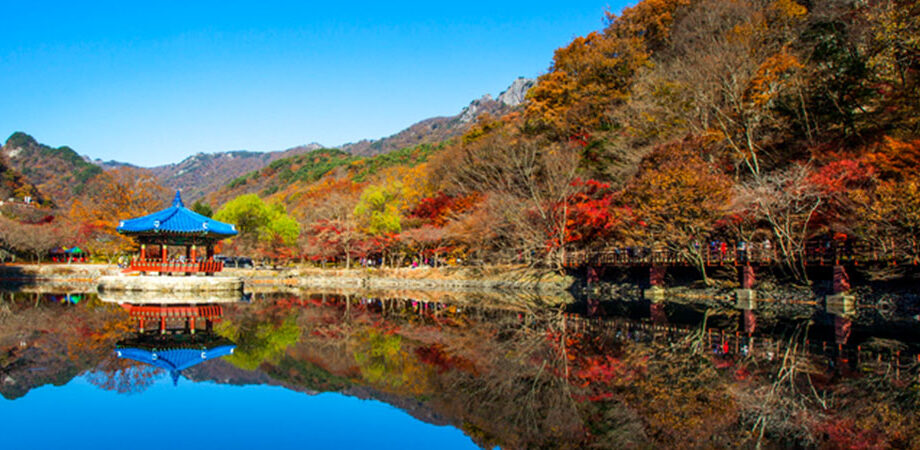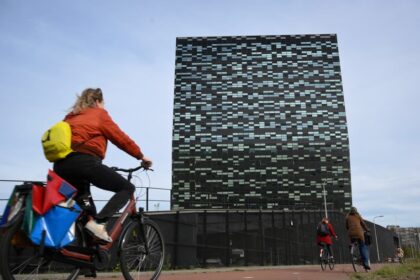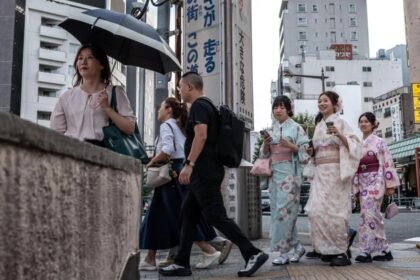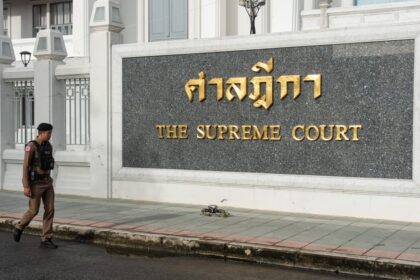Why Korea in Autumn Captivates Travelers
Autumn in Korea invites slow walks, crisp air and views that seem painted in layers of red, gold and amber. Mountains frame temples and streams, city parks glow with ginkgo and maple canopies, and curated gardens offer quiet paths among rare trees. The foliage season usually runs from October to November. Forecasts for 2025 point to a slightly later peak than recent years, a result of warmer conditions in September and early October. That timing shift matters for trip planning, especially if you hope to catch peak color on one or two travel days.
- Why Korea in Autumn Captivates Travelers
- When and Where Leaves Peak in 2025
- Naejangsan, The Classic Maple Wonderland
- Jirisan Piagol Valley, Three Reds in a Peaceful Gorge
- Bukhansan Uiryeong Trail, Wild Nature Inside Seoul
- Hwadam Botanic Garden, A Curated Canvas of Color
- Seoraksan to Hallasan, Other Iconic Mountains Worth the Trip
- City and Day Trip Favorites Near Seoul
- Hidden Corners and Regional Festivals
- How to Plan, What to Wear and Travel Smarter
- Highlights
Korea is largely mountainous, which concentrates color along ridges, valleys and forested temple grounds. Maple and ginkgo dominate the leaf show, but seasonal flowers and grasses also stand out. Pampas grass at Haneul Park, cosmos meadows at Olympic Park and silver grass fields on windswept peaks add texture to an autumn itinerary. Weather is typically stable, with cooler mornings and evenings. Expect average temperatures near 20 degrees Celsius in September, dropping to around 5 degrees in November. Layered clothing, a light insulated jacket and a compact umbrella work well in this season of big day to night swings.
The color front moves from northeast to southwest. Higher elevations turn first. Gangwon Province tends to show early change, Seoul hits its stride later in October, and the southern mountains and Jeju Island often hold bright color into early November. Understanding that progression helps you time visits to classic destinations like Seoraksan, Naejangsan, Jirisan, Bukhansan and Hallasan, along with city parks and historic palaces that are at their best in this season.
When and Where Leaves Peak in 2025
Travelers aiming for peak color in 2025 should plan for mid October through early November, adjusting by region and elevation. The following forecast windows reflect the expected first color and peak periods for key mountains and parks. Peak is roughly two weeks after first color and often lasts one to two weeks, depending on weather and wind.
- Seoraksan (Gangwon): first color (Sep 30), peak (Oct 23)
- Odaesan (Gangwon): first (Oct 6), peak (Oct 17)
- Bukhansan (Seoul and Gyeonggi): first (Oct 17), peak (Nov 4)
- Jirisan (South and North Jeolla, South Gyeongsang): first (Oct 13), peak (Oct 23)
- Naejangsan (North and South Jeolla): first (Oct 23), peak (Nov 11)
- Hallasan (Jeju): first (Oct 14), peak (Oct 30)
- Mudeungsan (Gwangju): first (Oct 21), peak (Nov 4)
- Songnisan (North Chungcheong): first (Oct 22), peak (Nov 3)
- Palgongsan (Daegu): first (Oct 18), peak (Nov 3)
- Woraksan (North Chungcheong): first (Oct 18), peak (Oct 28)
- Gyeryongsan (South Chungcheong): first (Oct 16), peak (Nov 1)
Leaves can hold beyond the forecast peak, especially in sheltered valleys. Strong winds or early cold snaps can shorten the window. Checking park updates in the week before your visit, and keeping a flexible schedule, will help you hit the best color.
Naejangsan, The Classic Maple Wonderland
Naejangsan National Park is a signature autumn journey. Crimson maples drape the slopes and line the entrance roads, and even short walks yield postcard views of footbridges, pavilions and mirror pools ringed with color. The Naejangsa temple complex sits in the heart of the park and dates to the seventh century. When late October gives way to November, surrounding ridges become a deep red amphitheater above the temple courtyards.
What to see
Plan time for Naejangsa and its approach path, where maple tunnels frame the mountain backdrop. Dodeok Falls and Geumseon Falls offer gentle walks with scenic payoffs. Nearby Baegyangsa temple, just outside the main valley, provides quieter scenes of water, stone and red leaves with reflections across the temple pond. The Naejangsan Maple Ecology Park, just beyond the main park boundary, explains native species and maintains maple tunnels that make an easy family visit, especially when crowds swell inside the park.
Practical tips
Peak color often lines up with early to mid November. Arrive early in the day for parking and quieter paths, and consider weekday visits. You can combine a stop with a meal in Jeongeup, known for excellent Korean beef restaurants that often draw weekend diners. If you prefer to minimize walking, the park roads are scenic and many viewpoints sit close to shuttle stops.
Jirisan Piagol Valley, Three Reds in a Peaceful Gorge
Piagolgyegok in Jirisan is famous for the sam hong effect, the three reds seen in mountains, water reflections and clothing during peak color. The valley trail runs about 6 kilometers from the entrance to Samhongso Pond, a gentle grade that suits families and casual hikers. The route passes Yeongoksa temple and quiet pools such as Yeonjudam, with natural stopping points for photos and snacks. Ambitious hikers can continue another 2 kilometers to Imgeollyeong Pass for wider views back over the valley.
The name Piagol carries layers of local history, first tied to millet fields, later connected to memories of conflict. Today the area is a place of reflection and calm. The annual Piagol Maple Festival brings forest concerts, traditional ceremonies and culture programs to mark peak color. In 2025, events are scheduled for Nov 1 to Nov 2, an ideal time for the valley’s most vivid scenes.
Bukhansan Uiryeong Trail, Wild Nature Inside Seoul
Bukhansan often surprises visitors with how wild it feels so close to downtown Seoul. Uiryeong, once a military restricted corridor through granite peaks and tight valleys, reopened to the public in 2009 and remains one of the park’s most preserved zones. The trail is a moderate walk, about two hours round trip, with forest cover and frequent leaf canopies in late October and early November. It exits in the Jangheung area of Gyeonggi, offering a short bus or taxi ride back to the subway.
Access is controlled by a reservation system to protect the corridor. Daily visitor caps keep the experience relaxed. After booking online, visitors receive a QR code, typically through KakaoTalk, which is scanned at the entry point. Comfortable shoes suffice for most walkers, and heavy gear is unnecessary. The Obong viewpoint gives a sweeping look at granite domes wrapped in color, a reminder that one of Korea’s great foliage walks sits within city limits.
Hwadam Botanic Garden, A Curated Canvas of Color
Hwadam Botanic Garden in Gwangju, Gyeonggi Province, offers a curated take on autumn. The garden is part of Konjiam Resort and was developed as an eco project focused on forest restoration and education. More than 4,300 species spread across 17 themed zones. Wooden deck paths wind past ponds, streams and hillside views, and plantings mix domestic and imported species with an emphasis on biodiversity and habitat health.
The annual Fall Festival runs from Oct 24 to Nov 16 in 2025, highlighting more than 400 maple varieties when they are at their most dynamic. Entry is limited to manage flow, with hourly and daily caps, and reservations are required. Visitors can walk the loop or take the eco monorail that circles the garden, a good choice for families and those with limited mobility. Because capacity is limited, booking a date and time slot well in advance is wise during peak color.
Seoraksan to Hallasan, Other Iconic Mountains Worth the Trip
Beyond the headline quartet, several mountains rank among the most rewarding places to see color in Korea. Each offers a distinct mix of rock formations, waterfalls, temples and ridge walks, which means you can match a destination to your hiking style and travel base.
Seoraksan
Seoraksan is usually the first major mountain to turn. Rugged granite spires rise above deep valleys, and trails vary from pavement near the entrance to steep stair climbs to high viewpoints. The cable car to Gwongeumseong provides an easy route to big views near the ridge. Hikers often link Biseondae and Ulsanbawi Rock for a full day among dramatic cliffs and pockets of color clinging to gullies.
Odaesan
Odaesan’s evergreen stands contrast with red maples in mid October. The Woljeongsa temple walk, mostly flat and lined with ginkgo trees, is one of the region’s calmest foliage experiences. The mix of stream, boardwalks and temple architecture framed by yellow and red leaves makes it ideal for photography without a long climb.
Hallasan
Jeju Island’s highest peak changes quickly once colder nights arrive. Trails such as Eorimok and Yeongsil lead to sweeping views of volcanic slopes brushed with crimson and gold, often with silver grass plumes waving in the wind. The late October peak lines up well with shorter island stays, and Jeju’s waterfalls and lava fields add variety to a color focused trip.
Palgongsan and Daedunsan
Palgongsan near Daegu pairs scenic drives with temple visits, most famously at Donghwasa. Roads ring the mountain, letting travelers stop at pullouts to photograph slopes covered in warm tones. Daedunsan in the central region is known for cliffs cut by staircases and a suspension bridge. Maple trees flank the steep approaches, giving hikers bright foregrounds against rock walls.
Juwangsan and Songnisan
Juwangsan features rocky valleys, waterfalls and ponds like Jusanji that mirror red and gold foliage in still water. Songnisan combines a classic forest walk with cultural stops around Beopjusa and its large Buddha statue. The forest trail is gentle and well suited to mixed ability groups.
City and Day Trip Favorites Near Seoul
Travelers who prefer short transfers have an abundance of choices in and around Seoul. Royal palaces light up with color that frames traditional eaves and courtyard walls. River parks and forested hills give easy access to ginkgo groves and maple clusters, and several day trip staples offer fall scenery with simple transport.
Nami Island has famous tree lined lanes, including metasequoias that turn orange and ginkgo rows that form a golden tunnel. Short ferry rides or a zipline transfer make access part of the fun. The Garden of Morning Calm focuses on themed plantings, bridges and ponds with maples draped over water features. A loop walk covers highlights in a relaxed hour or two.
Within the city, Changdeokgung and its Secret Garden, Gyeongbokgung and Deoksugung Stone Wall Road are classic palace spots. Seoul Forest Park and Olympic Park deliver wide open color, grassy meadows and quiet benches. Haneul Park crowns a former landfill with sweeping views and shimmering pampas grass. Asan Ginkgo Tree Road, reachable by public transport in about two and a half hours, offers a long double row of ginkgos that glow in afternoon light. Incheon Grand Park has a maple tunnel and mountain backdrop that make for simple half day outings.
Hidden Corners and Regional Festivals
Local tourism teams have been encouraging visitors to branch out beyond the biggest names, a strategy that spreads travelers across the map and allows quieter foliage walks. The Korea National Arboretum in Pocheon, often called Gwangneung Forest, is a standout with lake loops and fir forest paths rich in phytoncides. The decked Forest Ecology Observation Trail makes an easy route even for first time hikers.
Jangtaesan Recreational Forest near Daejeon is famous for metasequoia and cypress groves, a skyway and a lookout tower over treetops dressed in orange and copper. Hamyang Sangnim Forest in South Gyeongsang is a historic man made forest with a straight walkway through dense trees that blaze in late October. In Jeollanamdo, the Forest Resources Research Institute in Naju opens a healing forest with guided wellness programs among more than a thousand plant species.
Gyeongnam Province promotes a seasonal lineup that mixes nature and culture. Highlights include the Namgang Yudeung Lantern Festival in Jinju, air shows in Sacheon, and a German Village beer celebration in Namhae. Scenic picks run from the Geoje panoramic cable car, which gives a view of islands and hills, to Hwawangsan’s silver grass fields that ripple in the autumn wind. These destinations add variety to a foliage focused trip and reduce time spent in queues at the most famous parks.
How to Plan, What to Wear and Travel Smarter
Build your schedule around the north to south progression of color. Gangwon Province leads in early to mid October. Seoul, central regions and most national parks reach peak between late October and early November. The southern mountains and Jeju often glow through early November. For a week long trip, aim for one mountain day, one garden or palace day, one city park and neighborhood day, and one flexible day to chase the best color according to updates a few days before you go.
Crowd, safety and etiquette
Start early. Arrive at trailheads before 9 a.m. on weekends. Weekday mornings are best for quiet paths. Follow park signage, and carry out all trash. Respect temple grounds by keeping voices low and watching for areas where photography is limited. Many parks restrict drones. Sturdy walking shoes, water and simple trail snacks are enough for most day routes. Check bus or taxi options from trail exits, particularly for through hikes that do not loop back to the starting point.
Packing and transport
Pack layers, including a base layer, mid layer and light insulated jacket. Bring a compact rain jacket, a hat and light gloves for early and late outings. Comfortable footwear is more important than heavy boots on most popular paths. Public transport covers most foliage destinations. KTX or ITX trains reach Gangwon and the southeast quickly, while intercity buses link Jeolla and Chungcheong regions at frequent intervals. A rental car helps for multi stop days across smaller parks and gardens, especially in Jeolla where spacing between sites can be wide. Book controlled entries in advance, including the Uiryeong corridor in Bukhansan and timed entry at Hwadam Garden. Keep offline maps handy in case of weak mobile data in mountain valleys.
Highlights
- Peak color in 2025 is expected from mid October to early November, slightly later than recent years
- Naejangsan, Jirisan Piagol, Bukhansan Uiryeong and Hwadam Garden headline classic autumn days
- Key peak dates: Seoraksan (Oct 23), Jirisan (Oct 23), Naejangsan (Nov 11), Bukhansan (Nov 4), Hallasan (Oct 30)
- Reservations apply for Bukhansan’s Uiryeong corridor and for Hwadam Garden time slots
- Piagol Maple Festival runs Nov 1 to Nov 2, aligning with peak color in the valley
- Seoul area favorites include palace grounds, Olympic Park, Haneul Park and Seoul Forest Park
- Hidden picks: Korea National Arboretum, Jangtaesan Recreational Forest, Hamyang Sangnim Forest and Gyeongnam festival routes
- Dress in layers, start early, and track park updates for the freshest color reports












